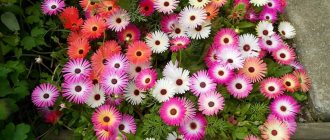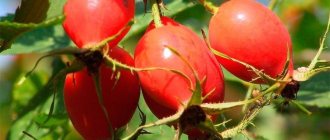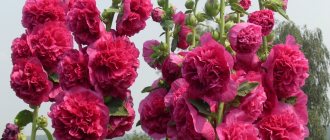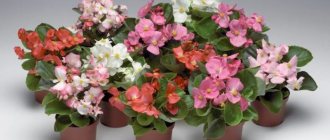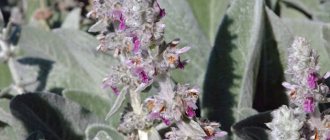Stone roses attract attention with their original appearance. This plant is considered one of the best for growing at home. Even if a lover of indoor plants has little space, you just need to allocate a small area with good lighting. Several small roses can be planted in one large and flat pot, the result will be a beautiful decorative element that will become a spectacular interior decoration. In this article you can find out what stone roses are, how to grow a plant in a room and in a flower bed, and how to care for it.
Varieties of rock rose
Stone rose (other name: young) is a plant that has an intricate appearance. Growing a flower is not difficult, as it does not require special care and attention. More than a thousand varieties are known.
Stone rose - an elegant decoration for the interior or landscape
Below are the most popular varieties grown in Russia and neighboring countries.
- Roofing. This variety is most famous in Europe. The flower has a spherical, slightly flattened shape, the diameter reaches 15 cm. The leaves are dense, with red-brown tips.
- Mountain. The plant consists of small, aesthetic, elegantly assembled rosettes. The buds are large with pink tips. Hybrid of mountain young - Brown's rose. The leaves are covered with pale yellow flowers.
- Caucasian. Grows on stone surfaces. The leaves have a dark green color. The Caucasian stone rose blooms with violet or lilac flowers, from a distance reminiscent of violets. This species needs regular fertilization. The plant requires a lot of calcium.
- The marble rose differs from other species in its variegated color with green-pink stains, which change color to red in winter. Reminds me of the surface of marble. The petals of this plant are painted in a calm red color with a white frame around the edge.
- Cobwebby. The most unusual and beautiful look of the young. The leaves are shaped like cones decorated with flowers. The unusualness of this variety lies in the cobweb that gracefully covers the plant. It looks impressive both in a vase and on an alpine hill.
- The runaway was rejuvenating. Has rosettes with a diameter of up to 5 centimeters. The color of the flowers is pale green or pale yellow.
- Wulfen stone rose. This variety attracts with its abundant greenery and beautiful small rosettes.
- Russian. The plant can be found in ordinary Russian forest-steppe. The rosette consists of large green leaves that are tightly packed and located closer to the center.

Varieties of rock rose
The stony rose looks very impressive and original. It can easily be grown in a pot or in the garden. An elegant plant can harmoniously fit into the interior of a room or into the landscape near the house or in the country.
For reference! Stone rose is an exclusively popular name used in Russia and the CIS countries. Also known are the names tenacious, hare cabbage.
The most common types of juveniles
In nature, there are about 50 different varieties of juveniles. This diversity became possible thanks to the plant’s ability to cross, also interspecific.
The most popular types of thunderweed include:
- Mountain rejuvenation (from Latin montanum). Fluffy, oblong-shaped jade leaves form tiny (only 2 cm) rosettes. Small white-lilac flowers are formed on short peduncles (4-8 cm).
- Dwarf rejuvenated (from Latin pumelum). A rosette, the diameter of which is 5–7 cm, is formed from jade leaves with pubescent edges. The flowers are lilac-red.
- Young Cassiopeia (from the Latin S. Cassiopeia). This variety is distinguished by the fact that it is able to change the color of the foliage with the change of seasons, from green to burgundy . It is characterized by high frost resistance.
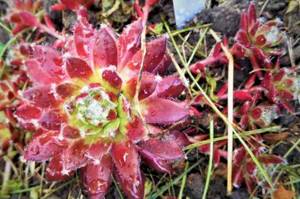
- Roofing rejuvenated (from Latin tectorum). Its rosettes, 4-20 cm in diameter, have a flattened spherical shape. The leaves are large, fleecy, bronze-burgundy. It blooms towards the end of summer, throwing out flower stalks up to 60 cm high, on which star-shaped flowers of various shades of purple are formed. Blooms for 40-45 days.
- Queen Amalia was rejuvenated (from the Latin reginae-amaliae). Rosettes of chestnut-colored leaves 10-15 cm in diameter. Blooms with pale yellow buds collected in a panicle.
- Marble rejuvenated (from Latin marmoreum). Almost flat rosettes with a diameter of 9-10 cm. New leaves are covered with short “lint”, which they lose as they grow up. The leaves have a burgundy tint along the edges and have a thin, olive border.
- Young offspring (from the Latin soboliferum). The spherical rosettes reach a diameter of 5 cm. The leaves are pale green, turning red towards the apex, and are crowned with cilia. Blooms in summer for 1.5 months. It produces peduncles 20 cm long with light yellow flowers.
- Cobwebby young (from lat. arachnoideum). Its small rosettes, 2-3 cm in diameter, are collected from elongated pointed leaves, the tip of which is slightly bent inward. Greenish-ruby color. Towards the center of the rosette on the leaf blades you can notice small white hairs, like a cobweb. Peduncle 30 cm high, covered with muted scarlet flowers.
- The Russian was rejuvenated (from the Latin ruthenicum). It has small rosettes (5-8 cm in diameter). The leaves are wedge-shaped, elongated, pale green, reddish towards the top, similar to chamomile petals. Peduncles reach a height of 35 cm. In July-August, pastel yellow flowers appear on them, which delight the eye for 40-45 days.
- The young are spherical (from the Latin globiferum). A rosette with a diameter of 4-5 cm of emerald leaves with a reddish tip. It blooms in mid to late summer with umbrella inflorescences of greenish-yellow flowers.
Conditions for plant growth and development
In order for the plant to develop normally and please the eye with an attractive appearance, it is necessary to provide it with appropriate conditions. Juveniles require bright lighting, regardless of the time of year.
Gerberas - what kind of flowers are they, planting and care in the garden
It is advisable not to place pots with plants on a windowsill that faces north, but to keep the flowers in the shade.
Additional Information! In winter and autumn, the plant should be watered moderately, no more than once a month.
In hot weather, that is, in summer and spring, the flower is watered less often when the earthen ball dries out, on average once every 10 days. There is no need to spray the petals.
In the winter and autumn seasons, the air temperature in the room where the young are grown should not fall below +10, and in the summer and spring exceed +22-27 degrees.
Varieties
Depending on the shape and color of the leaves, there are many varieties of the plant.
Juveniles are widely used as a decorative element in landscape design; there are many photos on the Internet with examples of the design of alpine slides and rockeries. It is advisable to stick to a single color scheme when choosing plants. So, lilac and pink carnations, phlox, sedum and many other plants look good with pink hare cabbage.
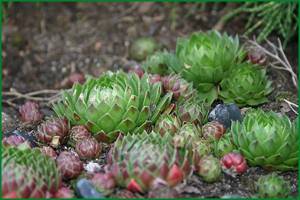
The choice of a specific variety must be made at the stage of planning a flower garden. By imagining what the composition will look like, you can successfully select varieties of hare cabbage.
- Roofing was rejuvenated. It has a decorative appearance - green leaves are framed by a red border. The diameter of the bush is 20 cm, height is 8 cm. The rosettes are often flattened or spherical in shape. It is a good element of rock gardens and combines with other plants.
- The cobwebby one was young. The plant is small in size and looks good in small flower beds and low rock gardens. When planted densely, it forms a neat mat.
- Wulfena. It is distinguished by fleshy leaves of soft green shades. Rosettes reach a diameter of 5 cm. Looks good in flower beds in autumn, giving the composition freshness.
- Russian made you look younger. The leaves are light green, rosettes can reach a diameter of 6 cm. Often found in pine forests.
- Marble. Due to its large rosettes and unusual leaf color, it is considered a royal variety. The leaves are predominantly red-green, with pink tips. The rosettes reach a diameter of 12 cm.
There are other plant varieties:
- Mountain young
- Offspring
- spherical
- Dwarf
Recently, a large number of plant varieties of hybrid origin have appeared.
How to plant a stone rose
Saxifraga - planting and care in open ground, in the garden, at home
When purchasing a plant, you should definitely read the description. You should also pay attention to the integrity of the outlet - it should be compact. In stores, roses are grown in peat mixtures, so it is recommended to transplant the plant into loose and light soil for succulents immediately after purchase.

Young sprouts of stone rose in pots
Juveniles have a shallow root system, which means that shallow pots should be chosen. A flat, wide container is suitable for planting succulents.
At the bottom you need to lay out a drainage layer, which includes pebbles, broken bricks or expanded clay. The thickness of the layer is at least 2 centimeters. If you don’t want to buy soil mixture for succulents, you can prepare the soil yourself.
For this you will need:
- turf soil - 3 parts;
- sand - 1 part;
- fine expanded clay - 1 part.
Before planting the young, you need to disinfect the soil. This can be done using boiling water (pour boiling water over the soil and cool).
Important! If the soil is not properly treated before planting, the shoots and roots may be affected by fungal infections, which actively develop in the limited conditions of the florarium.
Caring for the young
This decorative perennial is very easy to care for. All it needs is freedom from weeds and outdated rosettes, as well as loose soil. Juveniles practically do not require watering. Like all succulents, it stores moisture in its leaves. Approximately every 3-5 years, the “stone rose” needs to be replanted. This is necessary if you see that it is getting smaller.
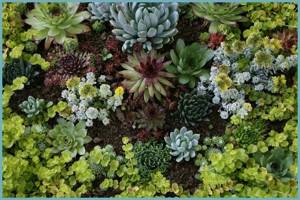
The young do not need constant supervision. It is enough to water it during dry periods. Attention! In arid climates and poor soils, you cannot forget about watering. It is undesirable for water not to get inside the sockets.
Dampness is contraindicated for the plant - it causes the lower leaves to rot. Make sure that the water in the open ground does not stagnate in the spring, when the snow melts, and in the fall, during periods of heavy rain. You don’t need to cover the young for the winter; it tolerates frost well. But if you propagated a perennial in the fall, make a “blanket” of spruce branches for the young rosettes.
How to properly care for a stone rose
The most important factor in the development of culture is sunlight. The plant must receive enough sunlight, otherwise it will lose its decorative qualities.
Planting roses at home and caring for them
But temperature is not the determining factor. Do not overdry the plant or allow the soil to freeze.
In the summer, it is advisable to take the rose out onto the balcony and place the pot there so that the flower receives direct sunlight.
For reference! The juvenile is not afraid of burns, as it is protected by a wax ball and individual fluffy leaves.
How to properly water and fertilize a stone rose
Fertilizing stone roses is carried out in spring or summer once a month. To do this, use the same fertilizers as for cacti and succulents. In winter, bait is not given.
In summer, the plant requires frequent proper watering, preferably with lower equipment, using a tray.
Attention! Do not allow liquid to get on the leaves.
To irrigate the stone rose, you should use well-settled water.
Flowering and dormant periods
Juveniles do not have a dormant period, they always bloom, it’s just that development slows down in winter.
In order to bring the flower to life, you need to leave it alone in a cool room. The crop blooms in most cases in the summer.
A beautiful earth rose produces one or more flowers. If the owner of the succulent does not plan to propagate the crop by seeds, then the flowers must be removed, otherwise the rose will begin to deplete.

Stone rose bloom
Errors when leaving
If the flower is not properly cared for, various diseases can develop. With a lack of lighting, the plant loses its aesthetics. If there is not enough sunlight, you should use phytolamps and use them to illuminate the plant.
If there is a lack of moisture, the leaves will begin to curl, then you need to water the flower. As the plant ages, the lower leaves begin to turn yellow - this is a natural process.
With excess moisture, the leaves become swollen and watery. If a lover of indoor plants notices these signs, you need to urgently inspect the roots and transplant the young plant into another pot and adjust the watering.
Disease and pest control
Stone rose is extremely rarely affected by pests. However, in rare cases, it still happens that the plant suffers from mealybugs, which destroy the leaves and root system.
It is not difficult to recognize the hated pest. These are colonies that look like dirty cotton wool on the leaves of the plant. You can remove the pest using alcohol-soaked cotton pads. Or just rinse with water. If the case is very advanced, then the soil and plant are sprayed with insecticides (in such cases, Aktara and Fitoverm are used).
Note! When the young are waterlogged or the soil is damaged by a fungal infection, they wither. You can get rid of this infection only in the initial stages, with the help of special drugs Fitosporin or Trichodirmin, which follow strict instructions.
Methods for propagating stone roses
The most popular and easiest way to propagate young plants is to separate small lateral daughter rosettes from the mother plant. It is advisable to use this method in spring, as this is the main phase of stone rose development. The sockets must be cut off with a knife, after disinfecting the tool. Each cut off daughter rosette is sprinkled with activated carbon and planted in the ground.

Methods for propagating stone roses
Propagation by leaf cuttings:
- from the mother bush you should cut off the side leaf that is located close to the trunk (or you can cut off the top of the stem);
- remove several leaves located below;
- cuttings take root within a few hours;
- then the lower part of the leaf or cutting is immersed in an impregnated (moistened) mixture of vermiculite and sand;
- install the cutting in a place that is brightly lit;
- periodically you need to spray the soil;
- in a month, small roots should appear, from which new rosettes will then develop.
This whole process takes time (2 to 3 months). During this period, wrinkling and drying of the mother leaf occurs. When the small rosette gets stronger, it will need to be transplanted into a wide pot with soil for cacti.
Germinating rock rose seeds
If the young are grown in stores, then problems, as a rule, do not arise. But few people know how to germinate seeds at home.
First you need to plant them in soil consisting of peat and sand, bury them 3-4 mm into the ground. Then you need to water the soil from a spray bottle and place it under the film.
An improvised greenhouse is placed in a warm, well-lit place with a temperature no higher than 20-25 degrees. It is important to regularly spray the soil with water and ventilate the room daily for 30 minutes.
Important! If everything is done correctly, sprouts will appear within two weeks. When real 2-3 leaves appear, they can be transplanted into separate pots.
“Stone” roses, as they are also called, are very spectacular indoor and garden plants that will delight the owner with their appearance and high decorative value for a long period. Original sockets come in different colors, shapes, and sizes. The plant is unpretentious and does not require special care. Busy and even lazy people love it. If you want to create a comfortable, cozy atmosphere in your home or decorate the landscape in your garden, a stone rose will help with this.
Species features
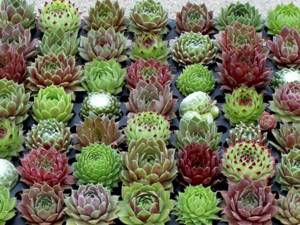
Variety of stone rose species.
Stone rose is a succulent of the Crassulaceae genus. In total, there are more than 4 thousand species of juveniles in the world, of which about 50 are suitable for cultivation in our climate zone. Modern hybrids are distinguished by a variety of shapes and shades of not only flowers, but also leaves.
The plant is interesting not so much for its flowering as for its neat rosette of leaves tightly adjacent to each other with pointed tips. The dense, fleshy leaves are green, brown, reddish, and sometimes combine several shades at once. Thanks to this, the stone rose is very popular in landscape design.
With the help of plants, not only flower beds are decorated, but also paths. The rosettes of the flower are pressed tightly to the ground. Juvenile has a small root system, so it takes root well even in small crevices - for example, voids between slabs. Stone flowers grow quickly and, having planted several rosettes, you will soon have a real carpet on your site, through which weeds cannot get through. It is easy to care for.
For growing in garden plots, the young roofing plant is more often used - the plant's rosette can reach 15 cm. The leaves are colored green, with reddish-bronze pointed tips. You can also find mountain juveniles, distinguished by smaller rosettes of leaves.





